CALResCo Group, 52 Mount Road, Middleton, Manchester. M24 1DZ. United Kingdom
An invited paper delivered to the 5th International Complex Systems Conference held at the University of Otago in Dunedin, New Zealand 19-21 November 2000. A video of this presentation can be found at the Complexity Digest website. Published in Steven Halloy & Tracy Williams (eds.). Applied Complexity: From Neural Nets to Managed Landscapes, pp. 53-87. New Zealand Institute for Crop & Food Research Ltd., Christchurch, 2000. ISBN 0478108192
Complexity thinking already challenges many of our deeply held scientific assumptions, yet by taking this conceptual analysis a stage further we can also reformulate science itself in a way that dissolves both objective-subjective and fact-value dualisms. This allows us extend science, using the evolutionary concept of fitness, into many areas previously thought unscientific and immune from falsification. In this paper we first look at the justification for doing this and then outline a new hypothetico-deductive-evaluative (HDE) metascience, which adds to traditional scientific methodology alternatives in state space, teleological goals, multidimensional values and an overall multilevel fitness evaluation. Employing this technique within complex systems requires that we take into account how values interact nonlinearly in real world cases, so we finish by looking at how to apply this methodology to human choice, examining the synergistic effects of part combinations in general and mind values in particular. This also suggests that fuzzy intuition and emotional thinking may be essential parts of any practical metascience fitness assessment process and helps us to bring together a number of threads of contemporary thought.
Applying complexity thinking to the world around us is a challenging task in many ways, it
widens considerably our potential scientific endeavours, it
gives us many new ways to think about scientific questions, and leads
us to challenge several of the assumptions embedded in our conventional scientific
methodology [Lucas2000b]. The complex system additions of nonlinearity, of emergence, of
multiple attractors, of edge of chaos and contextual evolution encourage us to consider
what else has been omitted from science and thus to criticize the basic assumptions on which
that science is based.
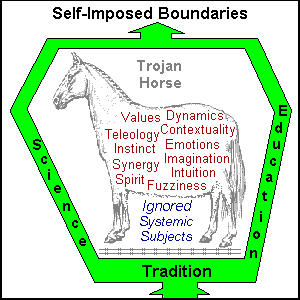 These axioms include the objectivity of the
scientific approach, the idea that science is value free and the notion that science cannot
help us to make moral decisions - the contrast between 'is' and 'ought'. We will challenge
all of these assumptions here and attempt to outline an extended metascience that can deal
with these issues.
These axioms include the objectivity of the
scientific approach, the idea that science is value free and the notion that science cannot
help us to make moral decisions - the contrast between 'is' and 'ought'. We will challenge
all of these assumptions here and attempt to outline an extended metascience that can deal
with these issues.
But a further philosophical assumption must also be challenged, the idea of disjoint dimensions, the notion that we can abstract out single features and treat them in isolation. What we must do instead, when considering complex systems, is to take into account both the interplay between attributes and equally important the interplay between levels, looking to apply science not to subjects in isolation but to the whole multilevel, multivariable hypersystem [Baas]. If we do this, then we often find that instead of arriving at a single equilibrium solution we obtain instead multiple far-from-equilibrium solutions distributed across state space. These solutions can be regarded as giving combinatorial or synergistic fitnesses and we can then employ our proposed metascience extensions in order to evaluate and choose between these alternative optima.
Part 1 considers the philosophy behind our science and why we should include values. We start by looking at what we can actually mean by objectivity, and relate this to the subjective mind that creates such a concept. Facts, the traditional lifeblood of science, are shown by association to involve values and we thus can claim that the traditional philosophical dualism between fact and value is an error caused by reductionist thinking. We extend this idea using fitness concepts to then show that ultimately 'ought' becomes optimised fitness, allowing us in principle to dissolve the barrier between descriptive and normative concepts. In Part 2 we examine what we mean by a scientific method and look at what we must do to incorporate the values of Part 1 into science. We outline a new scientific methodology, the hypothetico-deductive-evaluative method which brings the integrating ideas of complexity thinking into play in order to create an value based metascience. Part 3 extends this viewpoint to consider how we can use the HDE method to make social choices and this requires us to broaden the treatment into multiple dimensions, allowing us to treat conflicting values and contextual variation within a now localised science. The need to take into account emergence brings into play the concept of synergy which widens science to cover systems of increasing complexity, and this permits us to achieve a integrated scientific worldview that potentially can cover all realities.
If we are to avoid disagreement about what constitutes truth then there must be some criterion that does not depend upon relativistic personal opinion. This is what we mean by objective facts, those truths that are said to exist independently of human beliefs. To take an example, the statement that "a Rhino has a horn" can be said to be objective, if anyone doubts it they need only look, feel or otherwise check to verify that it is true, the truth can be ascertained independently of any one personal belief.
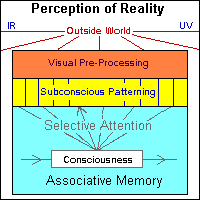 Yet even here we cannot exclude
subjective issues, it is well known psychologically [James1890] that our senses do not tell us the
whole truth and that the method of induction used extensively in science has no
logical grounding [Hume], nor can certain knowledge be gained by reason alone, since without
prior sensual data we have nothing to reason about [Kant]. Additionally, the very words
'Rhino' and 'horn' are ill-defined, and can only be regarded as meaningful on the
basis of a consensus social definition based upon cultural agreement [Wittgenstein].
Objectivity is at root no more than a consensus subjectivity (or intersubjectivity [Quine])
based upon a human viewpoint. What is regarded as 'truth' for humans
may not be valid for other creatures or for alien lifeforms [Lucas1996] which can
receive very different sense data, for example the echo location of bats, and consequently
may have evolved very different forms of mind [Nagel].
Yet even here we cannot exclude
subjective issues, it is well known psychologically [James1890] that our senses do not tell us the
whole truth and that the method of induction used extensively in science has no
logical grounding [Hume], nor can certain knowledge be gained by reason alone, since without
prior sensual data we have nothing to reason about [Kant]. Additionally, the very words
'Rhino' and 'horn' are ill-defined, and can only be regarded as meaningful on the
basis of a consensus social definition based upon cultural agreement [Wittgenstein].
Objectivity is at root no more than a consensus subjectivity (or intersubjectivity [Quine])
based upon a human viewpoint. What is regarded as 'truth' for humans
may not be valid for other creatures or for alien lifeforms [Lucas1996] which can
receive very different sense data, for example the echo location of bats, and consequently
may have evolved very different forms of mind [Nagel].
At least some (if not all) truth therefore relates to a viewpoint which is species dependent. It depends upon the abilities that we have to classify the world, sensually, mechanically aided and by the testimony of others [Traiger]. No truth can be expected to include all aspects of any subject, since our own limitations and desires necessarily must select out those aspects to be considered, in both time and space. What is objective and agreed upon depends as much on the number of people interested in a subject as it does on the possible attributes available to be measured, and this is especially true where we consider complex systems such as cells, minds and ecosystems. Facts relate to our collective interests, human and subjective, and the interests of a single highly specialist scientist are in this sense just as objective or subject to error as those of a group of specialists or the entire scientific (or human) population. In a similar manner any collective agreement about mental states must lead us to say that these are as objectively real as any external facts with similar levels of support [Velmans]. In neither the external nor internal case need a phenomenon be globally agreed, it is sufficient that we have a local agreement that the facts exist for more than one person, the greater the number that have experienced them then the better the consensus subjectivity we have, and this continuum between objective and subjective dissolves the duality between absolute and relative knowledge.
 But these facts (of whatever type) are not isolated, they do not exist as separate points
on a uniform background. Mental associations between facts make up the conceptual or cognitive maps in our brain, which form our understanding of the world. For example, when we see a 'Rhino horn' our brain associates multiple different instances of
creatures with horns, uses for horns, shapes of horns and so on, each with their own strengths. These associations themselves impose selective values on our thinking, relevances that relate to both our past experience and predispositions, values that are pre-linguistic [Clancey] and pre-conscious [Dreyfus].
We communicate consciously in symbolic language but think unconsciously in associations. At higher levels of language even our descriptive words include functional judgements, these we can call fusion words [Maslow] - e.g. clock, survival, brunch. As we move from facts about single objects to more abstract facts about collections of objects it is quite natural for our cultural values to infiltrate our descriptions. Indeed
this seems to be impossible to avoid, since facts without value are just noise. They again
form a contextual [Goldstone] continuum from total indifference (which would be the state of maximum objectivity
- disjoint facts) to single-minded personal obsession (the state of maximum subjectivity
- all facts interpreted to fit a preconceived pattern [Goertzel]).
But these facts (of whatever type) are not isolated, they do not exist as separate points
on a uniform background. Mental associations between facts make up the conceptual or cognitive maps in our brain, which form our understanding of the world. For example, when we see a 'Rhino horn' our brain associates multiple different instances of
creatures with horns, uses for horns, shapes of horns and so on, each with their own strengths. These associations themselves impose selective values on our thinking, relevances that relate to both our past experience and predispositions, values that are pre-linguistic [Clancey] and pre-conscious [Dreyfus].
We communicate consciously in symbolic language but think unconsciously in associations. At higher levels of language even our descriptive words include functional judgements, these we can call fusion words [Maslow] - e.g. clock, survival, brunch. As we move from facts about single objects to more abstract facts about collections of objects it is quite natural for our cultural values to infiltrate our descriptions. Indeed
this seems to be impossible to avoid, since facts without value are just noise. They again
form a contextual [Goldstone] continuum from total indifference (which would be the state of maximum objectivity
- disjoint facts) to single-minded personal obsession (the state of maximum subjectivity
- all facts interpreted to fit a preconceived pattern [Goertzel]).
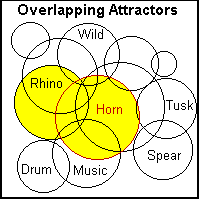 When we isolate a fact for philosophical or scientific discussion we artificially discard all
these links, we select one from many overlapping categories. We argue about an unreal case,
and it is this discarding of associations and dynamic context which leads us to believe that symbolic facts can exist in isolation, value-free [Rosenfield]. No useful facts can do this, and it is in the accumulation of associations that we move from vague understanding towards certainty, from low probability connections to high probability ones [Dewey1929]. Value here is not yet 'ought' in any moral sense, we have said nothing of relative value or motivation, the facts exist more in the sense of having an
inherent contextual meaning. A fact without associations has no meaning for us, one with
many associations has a rich meaning, for example we may have heard of Einstein's General Relativity but for most people this term would have little relevance, whereas for a mathematical physicist like Roger Penrose the meaning would be rich and far reaching. Thus we can say that the greater our familiarity with a fact (the stronger its presence in our mental world) the richer
will be our associations towards it, and the more significant will be its meaning to us. Physiologically
we are assuming here that this associativity occurs due to the ongoing strengthening of neural links to other neurons within each new situation - called Hebbian learning [Hebb]) leading to attractor formation which we can describe symbolically [Rockwell]. Meaning in our world relates to what the fact tells us about our universe, in other words what we can do with it, how it applies to our worldview, and it is this pragmatic use of facts using associations to find alternatives which provides the values in any context.
When we isolate a fact for philosophical or scientific discussion we artificially discard all
these links, we select one from many overlapping categories. We argue about an unreal case,
and it is this discarding of associations and dynamic context which leads us to believe that symbolic facts can exist in isolation, value-free [Rosenfield]. No useful facts can do this, and it is in the accumulation of associations that we move from vague understanding towards certainty, from low probability connections to high probability ones [Dewey1929]. Value here is not yet 'ought' in any moral sense, we have said nothing of relative value or motivation, the facts exist more in the sense of having an
inherent contextual meaning. A fact without associations has no meaning for us, one with
many associations has a rich meaning, for example we may have heard of Einstein's General Relativity but for most people this term would have little relevance, whereas for a mathematical physicist like Roger Penrose the meaning would be rich and far reaching. Thus we can say that the greater our familiarity with a fact (the stronger its presence in our mental world) the richer
will be our associations towards it, and the more significant will be its meaning to us. Physiologically
we are assuming here that this associativity occurs due to the ongoing strengthening of neural links to other neurons within each new situation - called Hebbian learning [Hebb]) leading to attractor formation which we can describe symbolically [Rockwell]. Meaning in our world relates to what the fact tells us about our universe, in other words what we can do with it, how it applies to our worldview, and it is this pragmatic use of facts using associations to find alternatives which provides the values in any context.
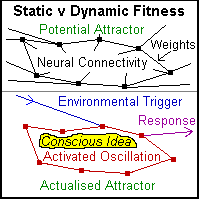 We can regard our accumulation of facts as giving us added fitness,
the more facts we have
the more combinations we can create and the more options or actions
that can be generated. Their physical associations or connectivity we can view as being a
static form of fitness, an unemployed form of knowledge - potential
gain. The facts in this case set up a set of vectors or directions following their associations,
paths which take us from one situation to a set of new situations. If we try to use
these facts in any way (e.g. for scientific prediction) then we are choosing to
follow a trajectory in state space along one of these possibility vectors, and this converts facts into the dynamic form of fitness that we can call a value-judgement or test. Values therefore relate to the use of facts within a dynamic process in order to change our fitness, to move us through the coevolutionary mental landscape in preferred directions [Hutcheon]. What
we view as fact and what we ignore relates to what we find useful and what we do not,
and this is as much a question of contextual viewpoint as of truth [James1897].
We can regard our accumulation of facts as giving us added fitness,
the more facts we have
the more combinations we can create and the more options or actions
that can be generated. Their physical associations or connectivity we can view as being a
static form of fitness, an unemployed form of knowledge - potential
gain. The facts in this case set up a set of vectors or directions following their associations,
paths which take us from one situation to a set of new situations. If we try to use
these facts in any way (e.g. for scientific prediction) then we are choosing to
follow a trajectory in state space along one of these possibility vectors, and this converts facts into the dynamic form of fitness that we can call a value-judgement or test. Values therefore relate to the use of facts within a dynamic process in order to change our fitness, to move us through the coevolutionary mental landscape in preferred directions [Hutcheon]. What
we view as fact and what we ignore relates to what we find useful and what we do not,
and this is as much a question of contextual viewpoint as of truth [James1897].
Science, despite claims to the contrary, is thus not value free. Our education uses facts to produce the equations relating them, and then uses these equations to make predictions about the dynamic changes in those facts with time. These predictions are fitness predictions and relate to our interests (we make no predictions about what does not interest us). We have once again a continuum here, between predictions that are of little interest to most people (e.g. the path of a nearby planetoid) and those of vital importance (the possible obliteration of Earth by a collision with that same object). The same facts therefore fuse with our individual and collective value systems in such a way as to generate and modify our projected fitnesses, and this contextual distinction can dissolve the fact-value dualism [Polanyi].
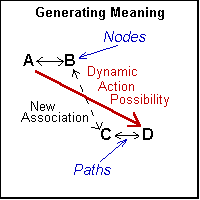 We have seen that facts need to fit in, that they are selected and collected within a worldview
and for a purpose, and that adding facts adds connections. This is what changes value-free to valued (e.g. the facts that location A connects to B, and C connects to D are fairly meaningless, yet when we say also that B connects to C we make a further association that adds value to the whole - we can then drive from A to D).
Facts are thus vectors, not scalars, combining them generates direction - in other words values.
Therefore we can see that quests for values are actually fact quests and vice-versa, the
necessary interconnections and associations ensure it. Our scientific development is about adding value (fitnesses) to facts,
without these values science remains static and useless. Knowledge also forces decisions,
indecisiveness (valuelessness) results from factlessness, once we accumulate
enough information our choices often seem clear, relative fitnesses become apparent,
we now no longer have to think about it [Epstein].
We have seen that facts need to fit in, that they are selected and collected within a worldview
and for a purpose, and that adding facts adds connections. This is what changes value-free to valued (e.g. the facts that location A connects to B, and C connects to D are fairly meaningless, yet when we say also that B connects to C we make a further association that adds value to the whole - we can then drive from A to D).
Facts are thus vectors, not scalars, combining them generates direction - in other words values.
Therefore we can see that quests for values are actually fact quests and vice-versa, the
necessary interconnections and associations ensure it. Our scientific development is about adding value (fitnesses) to facts,
without these values science remains static and useless. Knowledge also forces decisions,
indecisiveness (valuelessness) results from factlessness, once we accumulate
enough information our choices often seem clear, relative fitnesses become apparent,
we now no longer have to think about it [Epstein].
This idea is at the basis of our scientific thought, we perform experiments to explicitly obtain the facts that will prove or disprove our theories and to choose between them. We assume that an hypothesis is only as good as the extent to which it has been tested, the number of facts confirming it, and that the better the hypothesis the wider its scope should be, power here being its propensity to generate additional facts by suggesting research directions or applications. These issues comprise some of our scientific values. Taking note of this tendency for certain scientific values to determine what we ought to do as scientists, in other words which experiments we should pursue, shows that the idea that 'is' and 'ought' can be separated is false. In any human situation we have multiple options, multiple simultaneous values and choices. Which we pursue as an aim must be based upon some criteria, and this applies whether we call our pursuit science or not. To say that we 'ought' to do something is to say no more than it will give the best fitness or result in the context that interests us.
Given a fitness based science, where fact values relate to contextual fitness,
we need to briefly go back to our original dichotomy and consider the relevance
of the moral values often rejected in science - the idea that there are certain
things we 'ought' to do, regardless of facts. By bringing fitness into the
question however we can now take the view that what we ought to do, in
any evolutionary circumstance or mode of existence (physical, mental or spiritual)
is to try to increase fitness. This is so natural that we often fail to see just how
widespread in nature it really is. It permeates physics (energy minimisation),
chemistry (reactivity minimisation), biology (survival/reproduction),
body (immune system), mind (understanding), technology (cost), society
(quality of life). The spiritual or ethical dimension is only a minor additional viewpoint
and just as amenable to comparative value assessment as any other dimension.
Facts, what 'is', cannot be restricted to just material objects, many mental concepts
are immaterial and emergent, these properties go beyond the materialist world but
nethertheless exist.
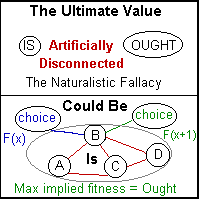 Similarly 'ought' cannot be divorced from facts, for the same
reason that they cannot be divorced from values, the whole meaning of 'ought'
implies an historical benefit to doing it [Dewey1902]
- and without values and facts we cannot evaluate such a concept.
Similarly 'ought' cannot be divorced from facts, for the same
reason that they cannot be divorced from values, the whole meaning of 'ought'
implies an historical benefit to doing it [Dewey1902]
- and without values and facts we cannot evaluate such a concept.
Thus 'ought' is only moral in the sense that certain behaviours are said to increase overall fitness (e.g. 'Thou Shalt Not Kill') and certain others will decrease it. This is an empirical question and relates to long term fitness, taking into account the wider environment and not just a selfish individual or a materialist account. So 'ought' can be said to be a processed or evaluated 'is' within the full context of our universe and worldview - a global fitness measure. In other words, we consider all the facts on the basis that they have values in our attainment of maximum Universal fitness. This 'ought' is the ultimate objective value and no more mysterious than the idea that we 'ought' to put oil in an engine [Taylor].
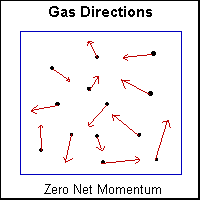 Many of the problems in reconciling facts and values stem from another
scientific misconception, the assumption that the world has no direction, that there
is no goal towards which evolution is aiming. Whilst this may be true for the
world as a whole, the idea that it is true for the parts also is logically invalid.
In any system, the parts may have direction, yet the whole may not (for example, in
a static container all the molecules are nethertheless moving
in particular directions). Only if the directions correlate can we say that
the whole has direction, and this need not imply a conscious or even a predictable one.
Many of the problems in reconciling facts and values stem from another
scientific misconception, the assumption that the world has no direction, that there
is no goal towards which evolution is aiming. Whilst this may be true for the
world as a whole, the idea that it is true for the parts also is logically invalid.
In any system, the parts may have direction, yet the whole may not (for example, in
a static container all the molecules are nethertheless moving
in particular directions). Only if the directions correlate can we say that
the whole has direction, and this need not imply a conscious or even a predictable one.
Thus we can allow teleology quite happily at the part level, and this is exactly what the concept of fitness implies. Any choice between possible alternatives or attractors is a choice between fitnesses [Cole], and this only makes sense if we employ some values to aid this choice, to define fitness itself. These values can be random for inorganic choices (by assuming all are equally fit, i.e. based upon no factual knowledge), a chemical gradient for a unicellular creature (a one dimensional fitness or awareness), all the way up to the complex multidimensional (philosophy based) fitnesses employed by our human species. The direction we take through state space is largely driven by our value related goals and thus by the facts and associations that create these values. These preferred directions are evident in all forms of life, and this applies to various degrees regardless of whether we are human, animal or plant [Laland, Odling-Smee & Feldman]. Our science must thus be expanded to include this teleological aspect, which merges the idea that our science has goals with the equivalent idea that the subjects of our science (including ourselves) may also have goals, and their complex combinations can be scientifically evaluated if we so choose.
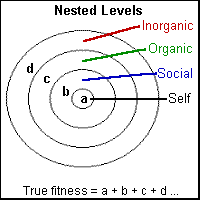 For any fitness decision we must understand the boundaries of the system
employing those values. This is a quite different emphasis from that of
conventional science, where it was assumed that the laws applied to
the whole universe, so that truth or fitness was a global measurement.
Here we must differentiate many different fitnesses, depending upon
how we define our system. This relativity relates to our knowledge or accumulation
of facts, the larger the context we have (i.e. the more extensive our education)
the more extensive or objective becomes our perception of the relative fitnesses
and overall effects of our options. This tells us that an interdisciplinary approach
to any complex question is likely to be more balanced than the bounded approaches
taken by conventional scientific or philosophical specialisms. What we take into account at any stage can critically affect the fitness values we use in our decision making.
For any fitness decision we must understand the boundaries of the system
employing those values. This is a quite different emphasis from that of
conventional science, where it was assumed that the laws applied to
the whole universe, so that truth or fitness was a global measurement.
Here we must differentiate many different fitnesses, depending upon
how we define our system. This relativity relates to our knowledge or accumulation
of facts, the larger the context we have (i.e. the more extensive our education)
the more extensive or objective becomes our perception of the relative fitnesses
and overall effects of our options. This tells us that an interdisciplinary approach
to any complex question is likely to be more balanced than the bounded approaches
taken by conventional scientific or philosophical specialisms. What we take into account at any stage can critically affect the fitness values we use in our decision making.
In the first instance we can use the concept of self, thus my fitness depends only upon my own desires and isn't related to yours - a purely selfish viewpoint. Another level adds you in, so we have a joint or social fitness (needed for example to communicate - it can be seen that this is an advantageous extension over the selfish view). Expanding further we can add life as a whole, and then the materialistic science levels. This recognition that fitness is not a single isolated value explicitly includes the in-between levels usually ignored by both sides in the dualist debate [Whitehead], those groupings that are neither global nor selfish viewpoints. All these levels can be assessed and be made part of science, extending our objectivity to cover the whole and not just a selected part of reality. It is inadequate in general to treat any level in isolation since this just ignores the wider implications. A true complex system science must take into account all possible levels unless we have good reason to believe that we can afford to do otherwise.
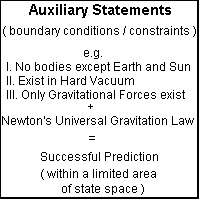
Scientific method nowadays relates to what is usually called the 'hypothetico-deductive method' [Losee]. In this we detect a mismatch between our data and our worldview and a new hypothesis is generated to explain this data. We make deductions from this hypothesis to arrive at some new predictions and experiments are then made to try to falsify [Popper] those predictions. If instead the results confirm the predictions, then we have confidence in our new hypothesis and it becomes a scientific theory or law. It should be noted that in practice 'scientific laws' are not applied in isolation but in conjunction with auxiliary statements or boundary conditions [Putnam], and these relate to the simplifying assumptions necessary to enable any theory to be applied in particular contexts.
Defining quality within our scientific theories concerns such ideas as scope, simplicity, consistency, completeness and symmetry - all of which are value laden structures.
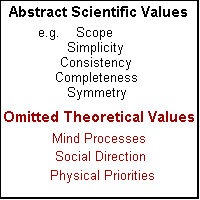 Given that we do at least have these values in science, then we need to understand
just why these particular values are chosen and how they affect our objectivity. We can redefine
objectivity here in fitness terms, in that being objective is being able
to evaluate fitness in any context without bias. Note that we do
not use the term 'personal bias' here, since we are formulating a
science that should treat equally both external and internal processes.
What is outside as an object may be inside for a personal goal, and thus
social norms can be subjective when applied to individual objective
goals. Cultural norms, whether religious (in acceptable forms of belief) or scientific
(in materialist dogmas) are forms of prejudice, and may prevent or interfere with objective
consideration of the actual values applicable to any particular case [Lucas2000a], intellectual honesty demands the openness
to question all our hidden values.
Given that we do at least have these values in science, then we need to understand
just why these particular values are chosen and how they affect our objectivity. We can redefine
objectivity here in fitness terms, in that being objective is being able
to evaluate fitness in any context without bias. Note that we do
not use the term 'personal bias' here, since we are formulating a
science that should treat equally both external and internal processes.
What is outside as an object may be inside for a personal goal, and thus
social norms can be subjective when applied to individual objective
goals. Cultural norms, whether religious (in acceptable forms of belief) or scientific
(in materialist dogmas) are forms of prejudice, and may prevent or interfere with objective
consideration of the actual values applicable to any particular case [Lucas2000a], intellectual honesty demands the openness
to question all our hidden values.
This form of value relativity is actually context relativity and we can objectively enumerate this if we wish by explicitly defining the contextual limits. Scientific facts are such contextuals, for any experiment only certain ones have relevance (e.g. facts about bees are useless in cosmology). Relevant here is equivalent to valued. Our experiments select out from our full range of values certain ones that we consider important for the problem under consideration. The values currently incorporated into science are abstract ones, they relate not to the material world but to a Platonic world of ideals, a perfect world of mathematical beauty. That we include such aesthetic ideas at the core of our scientific practice shows us the impossibility of excluding human values from our scientific methodology, so it is natural to investigate further how best to include them.
In traditional science we often regard experiments as purely material acts. Thus something is regarded as 'science' only in so far as we can perform physical measurements upon it. Yet this is a very limited viewpoint, and neglects much of our world, especially that vital aspect that we call mind and which defines the scientific process itself. An experiment is really just a way of searching for data and testing it against a theory. Often, before the possibility of a physical experiment, we perform thought experiments (a favourite of Einstein for example). In this way we model a scenario in our minds utilising our empirical associations so as to check out our theoretical understanding of the subject, the general validity of our model [Sorensen]. Many theories are rejected at this stage and it is perhaps true that this mental falsification of tentative theories owes more to genuine scientific principles than the culturally entrenched ideas seen in day-to-day scientific behaviour [Kuhn].
Within the abstract thought world of our mind all aspects are theoretical, so this form of mental experiment comes into its own. Such discussions are of course not new, philosophy has been around for thousands of years and often uses such test cases. What we need to add however here is a suitable scientific valuation. We need to ask in what way do the various alternatives suggested increase or otherwise affect fitness ? This question moves the issues from a non-scientific to a scientific form - they become testable against our chosen value criteria. Thus we are able to bring the wider world of the mind under the scientific umbrella, and this involves a change in emphasis from experiments on static objects to experiments on dynamic processes (which can be non-material, e.g. in the form of mind). Bringing in a process emphasis naturally includes evolutionary concepts, since process thinking can easily accommodate changes that a more static treatment tends to exclude [Rescher]. The idea of natural selection then gives us a potential fitness criteria with which to compare theories, those having the greatest benefit will be chosen by our consensus subjectivity as survivors against whatever teleological values we choose to employ.
Traditional science was all about controlling the world, the predictions were to allow mankind to dominate nature, to force it to fit his many one-dimensional needs - with each considered in isolation, following reductionist methodologies, which excluded any emergent properties and coevolutionary effects. If we expand science, then this is no longer acceptable, since taking into account also the environmental needs of nature, as well as human needs, requires that we maximise the benefits to all and not just to humans in short-term isolation. Science should be about potentiality, it should show us the objective possibilities for action (and in an expanded view also highlight the effects of those possibilities on our values) but in itself science should not choose any of them for implementation - it does not yet contain the full picture. If we fail to allow scientific precision and methods in overall fitness assessment then this leads to decisions being made instead on less objective grounds or being forced choices, and this must lead to prejudices and inaccuracies that could so easily be avoided.
Scientific work can continue of course without considering any wider values, but this needs to be made explicit and such science divorced from that direct simplistic influence in decision making that we see too often (since, by design, it fails to take account of valid contextual data). The faith placed in scientific pronouncements based on one-dimensional research is an erroneous one, due to the inevitable failure of these scientists to take into proper account the wider issues beyond their specialisms. A new breed of interdisciplinary contextual scientists are required to bring together the wider interplay of coevolutionary effects and values in the assessment of fitness.
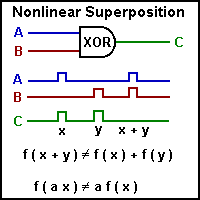 Rather than the intrusive experiments of conventional thinking (or the isolated
one-dimensional 'value free' reductions often employed) we should look in complex science to
experimental forms that are non-intrusive (as far as possible) [Gergen].
In other words observational experiments which collect data from real life operations without
disturbing them in the process, or complex computer simulations where
alternatives can be modelled in a multidimensional and coevolutionary way.
The dangers of juxtaposing single-dimensional conclusions and assuming
they can be applied to the multidimensional case cannot be stressed enough.
This procedure is invalid in the case of nonlinear systems, the mathematical
principle of superposition does not hold (e.g. f(x+y) is not equal to f(x)+f(y)
and f(ax) is not equal to af(x) ), so if the best option for me is A and for you
is also A this does not mean that the best combined option
will be A (e.g. see the Prisoner's Dilemma scenario in Game Theory [Axelrod]).
Rather than the intrusive experiments of conventional thinking (or the isolated
one-dimensional 'value free' reductions often employed) we should look in complex science to
experimental forms that are non-intrusive (as far as possible) [Gergen].
In other words observational experiments which collect data from real life operations without
disturbing them in the process, or complex computer simulations where
alternatives can be modelled in a multidimensional and coevolutionary way.
The dangers of juxtaposing single-dimensional conclusions and assuming
they can be applied to the multidimensional case cannot be stressed enough.
This procedure is invalid in the case of nonlinear systems, the mathematical
principle of superposition does not hold (e.g. f(x+y) is not equal to f(x)+f(y)
and f(ax) is not equal to af(x) ), so if the best option for me is A and for you
is also A this does not mean that the best combined option
will be A (e.g. see the Prisoner's Dilemma scenario in Game Theory [Axelrod]).
A metascience, able to consider all aspects of our universe, mental as well as physical, needs to be based on a metahumanity, a view of humanity that in itself dissolves the barriers that separate us from the physical world and limit us as individuals (the subject/object dualities). Science is ultimately a social activity, it relates to a consensus view of the world. This consensus can be made at a low metaphysical level or at a high one, in other words it can operate within a restricted world view or can grow to embrace the full possibilities of our reality, the full spectrum of needs.
These are those related to lower animal or plant behaviour, essentially
concerned with the physical world and our physical existence. They include
eating, drinking, breathing, growth, response, shelter/warmth, reproduction,
security/survival, resting, waste disposal and health. They relate to the emergent
properties of life itself.
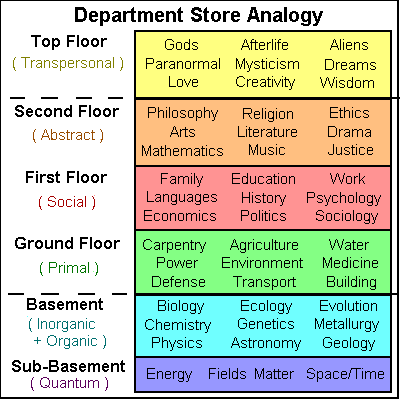
Moving up to a higher level we have the more sophisticated needs associated with the emergence of mind and community in the middle and higher animals. These add to the list such needs as communication, display, status, belonging, curiosity, stimulation, pleasure, mobility, play, comfort and forward planning (resource stockpiling and simple goals).
At the top of the needs hierarchy are those higher needs attributed to fully developed humans, and these are usually claimed to be applicable only to our species. They encompass, amongst others, arts, music, science, mathematics, religion, love, philosophy, truth, justice, ethics, history, beauty, compassion, sensitivity, companionship, equality, creativity, education, wisdom, unity, inner calm, insight or enlightenment, and freedom. These levels show the emergence of concepts of a non-material form, the higher levels of consciousness often explicitly excluded from science although they correspond to the same mode of thought as science itself.
Each of these groupings corresponds to different emergent levels in a complexity view (each may also contain sub-levels) and for a full scientific picture we should also include levels below and above this human centred viewpoint (the department store analogy). Traditional scientific fields have focused exclusively on single levels (e.g. physics, chemistry, biology, psychology, sociology) in closed systems, but if we are to take science into a new interdisciplinary era we must address the relationships between these levels, generating a multi-level scientific methodology where all the levels are regarded as open systems. Metascience, as defined below, is a viewpoint that does this, taking into account the personal, social and environmental effects of our actions as an holistic hypersystem, rather than in isolated chunks.
Having defined metahumanity we can now look at how we can apply these ideas to science. We saw earlier that values could be objective, so we can relate our metaneeds to this by saying that these should comprise our scientific metavalues, the desired fitness goals of our metahuman science. In other words, we wish our science to give us the knowledge we need in order to best achieve these ends, and this gives an overall direction to our scientific enterprise. It will be noted that these values are not generally material ones, but none of our scientific values are such since they comprise emergent properties of mind. By explicitly grounding our science in the non-material world we free ourselves from the delusion that science cannot speak about psychological or spiritual concepts - it already does so implicitly.
Current science is often regarded as a search for pure knowledge, value free facts, yet we know that facts without context are just noise and the scientific context itself imposes values. Science must say not only what there is, but also what this implies and not conceal or ignore valid contextual significances. Our required change here is to take account of not just a single set of values (relating to consistency, scope, prediction and so on - all those abstract level scientific values) but to add in the other metavalues also. In both mind and world all these needs are inter-related and thus a complex science cannot act as if they are independent. We must formulate a scientific methodology that can incorporate and appraise values beyond those common to our sciences of the simpler aspects of life.
The addition of wider values gives us a methodology which we can call the
'hypothetico-deductive-evaluative (HDE) method'.
The additions relate to how our scientific theories correspond to metahuman
goals, in other words how do they help us to enhance our overall fitness creating actions,
and to ask are they the best theories that can be used for this purpose ?
Science is about the systematisation of all our knowledge,
so already includes a number of concepts, e.g. hypotheses (tentative conjectures), deductions (predictions), experiments (tests), theories (laws).
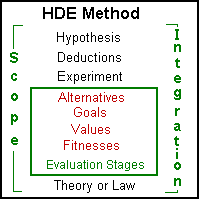 What is not yet included is alternatives, goals, values or fitnesses - those operations
relating to possibility, direction, usefulness and context.
What is not yet included is alternatives, goals, values or fitnesses - those operations
relating to possibility, direction, usefulness and context.
The Four Evaluative Additions
Most science restricts itself to finding a single theory that fits the facts. Alternatives
are seen only when disagreements between scientists lead to differing hypotheses
being proposed. Yet the first theory to be thought of is not necessarily the best,
nor is the second or third. In complexity thinking state space has many possibilities and
an important aspect of metascience thinking is the identification of the full range of options
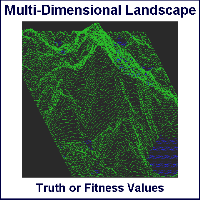 in any situation, thus dissolving the dilemma or forced choice scenarios implied by
dualist thinking [Whitbeck].
This is hard to do, and often the better options are screened off
from us by our own assumptions (e.g. Einstein's General Relativity was unthinkable
within a Euclidean geometry assumption). Evolutionary thinking however, with
the concept of a fitness landscape, can aid us in considering the wider possibilities
and in choosing the option that maximises our goals. This idea is more difficult to
apply in multidimensional contexts, but relates to understanding the elements of
our theories, their combinations, interactions and criticality in achieving the desired
result. It should be possible to formalise this theory space, but we will here only
emphasise that multiple alternative theories always exist.
in any situation, thus dissolving the dilemma or forced choice scenarios implied by
dualist thinking [Whitbeck].
This is hard to do, and often the better options are screened off
from us by our own assumptions (e.g. Einstein's General Relativity was unthinkable
within a Euclidean geometry assumption). Evolutionary thinking however, with
the concept of a fitness landscape, can aid us in considering the wider possibilities
and in choosing the option that maximises our goals. This idea is more difficult to
apply in multidimensional contexts, but relates to understanding the elements of
our theories, their combinations, interactions and criticality in achieving the desired
result. It should be possible to formalise this theory space, but we will here only
emphasise that multiple alternative theories always exist.
Goals relate to our indeterminate choice or control of our direction, which depends
upon our worldview. Rather than testing a theory in isolation (against limited data), it is
better to test alternative theories against each other. These tests are then effective
in choosing between optional theories within such worldviews.
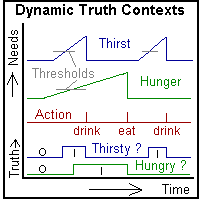 This is an localised idea of
science, in which theories don't reflect fixed truths but take into account
their dynamic context or purpose, what the theory is meant to achieve. This explicitly
considers theory generality and thus overall human value - a theory that does not apply
in many cultural settings is less 'scientific' than one that can survive in varied contexts.
This brings science into line with our general social behaviour
and implies that tests should be based upon multiple relevant needs. Restricting the values
tested is restricting the theory scope and thus its generality and quality. If oversimplification
is needed, as in many traditional experiments, then it is up to the scientists involved
to justify the additional constraints that they have chosen to place upon their
experiments, and of course the extrapolation of the results must be restricted
therefore in the same way (to situations where those constraints and
independencies explicitly hold).
This is an localised idea of
science, in which theories don't reflect fixed truths but take into account
their dynamic context or purpose, what the theory is meant to achieve. This explicitly
considers theory generality and thus overall human value - a theory that does not apply
in many cultural settings is less 'scientific' than one that can survive in varied contexts.
This brings science into line with our general social behaviour
and implies that tests should be based upon multiple relevant needs. Restricting the values
tested is restricting the theory scope and thus its generality and quality. If oversimplification
is needed, as in many traditional experiments, then it is up to the scientists involved
to justify the additional constraints that they have chosen to place upon their
experiments, and of course the extrapolation of the results must be restricted
therefore in the same way (to situations where those constraints and
independencies explicitly hold).
It is these unspoken constraints that often allows science to appear exact, but such mathematical precision is frequently the result of employing such tight constraints that possibility is forced to conform to minute areas of state space, i.e. apparent accuracy is inversely proportional to allowed freedom - a social form of the uncertainty principle [Heisenberg]. Freedom to consider multiple values implies that we must relax our obsession with absolute one-dimensional truth and this has major repercussions as to how we view science, in that we now recognise that our scientific constraints or beliefs are imposed values that may in themselves have no justification. We must explicitly examine these boundary conditions before acceptance, with a view to determining whether the options forced to be constant (the controlled conditions) are such that the results restrict or invalidate application of the theory in practice, in other words it proves to be a theoretical fabrication with little or no practical value.
 Values relate not to 'things' but to 'processes' or relationships, and by refocusing
science onto processes instead of objects we can more easily relate
our thinking to the hidden values that are behind our scientific assumptions.
In general a process has a function, an evolution, and this forms a transformation
from some initial state to a final one. Objects are a form of process (a static
one in effect) where the input and output are equal, so will still be included
in a process based science. Processes include both internal interconnections (function)
and external interactions (environmental context). It is in the coevolutionary interplay
of these two aspects that we must judge the fitness results.
Values relate not to 'things' but to 'processes' or relationships, and by refocusing
science onto processes instead of objects we can more easily relate
our thinking to the hidden values that are behind our scientific assumptions.
In general a process has a function, an evolution, and this forms a transformation
from some initial state to a final one. Objects are a form of process (a static
one in effect) where the input and output are equal, so will still be included
in a process based science. Processes include both internal interconnections (function)
and external interactions (environmental context). It is in the coevolutionary interplay
of these two aspects that we must judge the fitness results.
Putting values back into the assessment of the fitness of a theory means including these wider context implications also. In other words, we ask if the explanation helps us to make judgements that increase our fitness and that of our world. The effective use of knowledge (and that is what science aims to provide) means that it must be seen to be compatible with human and wider needs, and here that means metaneeds also. A scientific theory must structure the world in a way that promotes positive actions (if it is to be of benefit), and if two theories only differ in this aspect then this criterion is a valid one by which to choose between them.
We must also take account of the social implications of any theory. Unlike supposedly 'value-free' theories, which maintain that position by being artificially divorced from context and thus single-dimensional, value related theories must integrate with all aspects of life. Thus if a metascientific theory is to be successful it must dissolve barriers between its field and the rest of our world and not increase them. This requirement leads us naturally to systems thinking, as it is a criteria of that approach that theories should be applicable in an interdisciplinary way and should take account of emergent holistic properties.
Let us suppose that we have executed a traditional scientific process and arrived at a tested scientific theory. Before we proceed to apply it, we now need to ask some additional questions relating to how it affects fitness. This is the 'evaluative' stage we have added to conventional science (we are assuming here that it follows the conventional sequence, but ideally it would integrate with the hypothesis stage onwards in order that we would test only the better theories). We can divide this into six stages - a complex systems look at scope, the four additions and a final social integration overview :
Does it need some of the traditional scientific assumptions, and if so can a reformulation widen its generality (perhaps moving an existing axiom to a local constraint instead) ? This question helps us to understand the contextual limitations that result from our normal thought processes and the possible benefits of relaxing them. It makes explicit the boundaries of the proposed theory and indicates whether it is a systemic theory applicable to all levels or is restricted to specific modalities or subjects.
Here we explicitly widen the search space, using the characteristic of this theory to help prompt our imagination to discover alternatives across state space. We can also use the identified scope to formulate more general hypotheses applicable to wider areas of our reality. Here we look to identify the best formulation of our theory, the one with potentially the greatest benefits.
Traditionally this could be pure knowledge, but we can ask what others needs are potentially affected and what knock-on effects this theory may have on other existing theories and views of life. This aspect asks about the value of the theory for humanity, i.e. what use it can be, what is it intended to do ? Does it force changes in any social and/or scientific norms ? Can we use it to question current assumptions and our wider expectations ?
How does it inter-relate to our current associations. Does it clarify any of our values, does it add any new ones ? Here we look to understand what practical effect the theory can have on our world view, in other words what additional fitness information or associations it potentially supplies, relevant to our needs.
How does this fitness information relate to the overall context ? Does the theory help us to generate new life options and if so are these positive or negative in overall effect ? This relates to how the various values created interconnect and compromise in producing an overall fitness evaluation for each alternative.
Does it have a stabilising or destabilising influence on our society ? Does it help to unify matter, mind and spirit or separate them ? Does it reduce conflict, prejudice and specialisms or increase them ? This is the highest level holistic value, the global 'ought' and relates to a viewpoint that rates every level equally as contributing to universal fitness, asking how the theory fits into our overall worldview.
Some form of self-experimentation is needed in order to answer these questions, since they all relate to abstract (non-material) implications of the theory and are thus internal to our minds. Yet these are all open to objective examination, we can document and share our reasoning before arriving at a consensus scientific position as to the significance of any theory in these evaluative terms, an example follows (Table 1):
Metascience Evaluation ExampleThe Theory of Evolution by Natural SelectionNeo-Darwinism states that organisms evolve gradually based on random genotypic variations causing fitness differences in phenotypes which are then preferentially selected for survival and reproduction. Scope - Moving the genome to a local constraint widens the theory to apply also to uncoded systems (e.g. ideas, immune systems, ecosystems and brains). Selection can be both natural and artificial, and random variations can be combined with directed ones, giving a general multilevel theory of change. The original theory is a narrowly constrained version of a much wider general evolutionary theory, and unjustifiably restricted to biology and genetic evolution. Alternatives - We can question the assumptions of 'gradual', 'random', the causing of phenotype changes, preferential selection and so on, generating many alternative formulations for comparative testing, including the complexity science 'attractor' variant. Goals - The traditional goal is just reproduction or survival, but in the wider formulation can relate to our overall needs, with contextual goals. This multidimensional formulation better describes organism behaviour and then has social implications relating to quality of life. Values - Survival has a number of knock-on effects, especially in ecosystem terms. Preservation implies information continuity, the usefulness of knowledge (in whatever form). We can also consider our needs hierarchies and all the values that have a bearing on survival and well being. Fitnesses - This relates to balancing our goals, to compromise between multiple values. We can reformulate natural selection in non-competitive terms by saying that that which adds fitness is selected, and this can be cooperation. We can investigate how the values interact and how the alternative combinations affect fitness. Integration - Fitness as a coevolutionary value helps integrate the world, and as this cannot be decided correctly 'context free' it helps relate behaviours to wider viewpoints. We can see that simplifications that leave out the wider (group or ecosystem) contexts lead to divisive views of evolution, by creating disjoint fitness measures for separate parts. |
 It is all very well to talk about a wider view of science, but we must also ensure that this
is a practical aim.
Over the last few decades there has been a considerable growth within social areas
in providing decision aids for evaluating alternatives, especially within the Operational Research and Management Sciences areas, for example Decision Trees which take into account
costs, probabilities and benefits. Whilst much has been done, there seems however no consensus
that the methods provided are effective [Clemen, Menzies], indeed they can actually make matters
worst if the canalisation of our thought leaves out critical variables or ignores parts of state space [Brown], and these methods are often not applicable to nonlinear interrelationships [Hsiao]. Going beyond a low dimensional reductionism requires us to choose amongst options based on what are often large numbers of unclear and conflicting criteria. Many of our multicriteria optimisation methods are also
mathematically complex [Coello, Minker] and unsuitable for general use by the population at large, who continue to rely on simplified rules of thumb or historical prejudices
[Lucas1999b], for example in economics where generally only financial dimensions are taken into account [Eckland & Tollison] and the effects on other unquantifiable values are shunted to a no-man's-land and then ignored
[Schumacher]. The limitations of such rational economic models are
gradually being recognised but much work remains to be done [Gintis & Romer, Henderson]
It is all very well to talk about a wider view of science, but we must also ensure that this
is a practical aim.
Over the last few decades there has been a considerable growth within social areas
in providing decision aids for evaluating alternatives, especially within the Operational Research and Management Sciences areas, for example Decision Trees which take into account
costs, probabilities and benefits. Whilst much has been done, there seems however no consensus
that the methods provided are effective [Clemen, Menzies], indeed they can actually make matters
worst if the canalisation of our thought leaves out critical variables or ignores parts of state space [Brown], and these methods are often not applicable to nonlinear interrelationships [Hsiao]. Going beyond a low dimensional reductionism requires us to choose amongst options based on what are often large numbers of unclear and conflicting criteria. Many of our multicriteria optimisation methods are also
mathematically complex [Coello, Minker] and unsuitable for general use by the population at large, who continue to rely on simplified rules of thumb or historical prejudices
[Lucas1999b], for example in economics where generally only financial dimensions are taken into account [Eckland & Tollison] and the effects on other unquantifiable values are shunted to a no-man's-land and then ignored
[Schumacher]. The limitations of such rational economic models are
gradually being recognised but much work remains to be done [Gintis & Romer, Henderson]
If we are to influence the general behaviour of the populace, the concepts that are used
must be easily assimilated and not restricted to people possessing specialist knowledge.
Science should not be, as currently seen, a technique divorced from the world of ordinary
people but should be an intuitive part of everyday lives.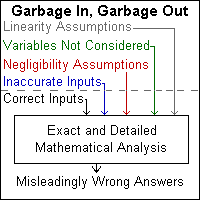 This is less difficult than it may
seem at first glance, since the general tenets of metascience, the idea that we test values against
each other in order to make decisions, is already part of our political and social
worlds [Harris].
Indeed this 'trial and error' experimental process forms the basic technique by
which we, as children, learn about the world and how to act socially [Kelly, Piaget, Bickhard1999b, Campbell & Bickhard]. It is the extensive shielding of scientific ideas under a mathematical umbrella that has artificially divorced science from the general public (who have little mathematical interest and often make decisions on other than rational grounds [Leiser]).
This over reliance upon mathematics in science often leads to situations where inadequate
attention is paid to the context, leading to pseudo-accurate quantitative solutions that if our initial assumptions are wrong are in practice useless, the garbage-in, garbage-out idea familiar from
computer science. But we should note that, despite the obvious emphasis seen today,
mathematics is not an essential part of science, merely an aid (a form of shorthand), and by
moving the mathematics to a back seat we can better reinstate metascientific ideas into
the lives of common folk [Smith & Casati]. If we fail to do this it is likely that formal science will remain as irrelevant to the day-to-day behaviour of the masses as it has been throughout its history, with the colossal fitness
losses that result.
This is less difficult than it may
seem at first glance, since the general tenets of metascience, the idea that we test values against
each other in order to make decisions, is already part of our political and social
worlds [Harris].
Indeed this 'trial and error' experimental process forms the basic technique by
which we, as children, learn about the world and how to act socially [Kelly, Piaget, Bickhard1999b, Campbell & Bickhard]. It is the extensive shielding of scientific ideas under a mathematical umbrella that has artificially divorced science from the general public (who have little mathematical interest and often make decisions on other than rational grounds [Leiser]).
This over reliance upon mathematics in science often leads to situations where inadequate
attention is paid to the context, leading to pseudo-accurate quantitative solutions that if our initial assumptions are wrong are in practice useless, the garbage-in, garbage-out idea familiar from
computer science. But we should note that, despite the obvious emphasis seen today,
mathematics is not an essential part of science, merely an aid (a form of shorthand), and by
moving the mathematics to a back seat we can better reinstate metascientific ideas into
the lives of common folk [Smith & Casati]. If we fail to do this it is likely that formal science will remain as irrelevant to the day-to-day behaviour of the masses as it has been throughout its history, with the colossal fitness
losses that result.
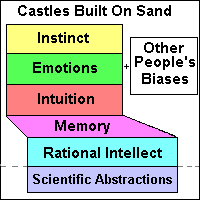 The philosophical idea that humans behave rationally, dominant since Greek times, has forced
into a corner consideration of our other conscious or unconscious abilities. How do we or the public make decisions on a day-to-day basis ? It is rare for us to rationally sit down and work out the implications of our choices in the way suggested by formal decision analysis techniques. These are reserved for important, often optional, decisions where we have plenty of time and resources. Reason was defined by [James1890] as "the substitution of parts and their implications or consequences for wholes" and this abstraction and simplification is of course highly valuable in scientific analysis,
where mathematics can be used to predict regularities amongst these parts. Yet the reverse stage
is also necessary, the synthesis of all these part views to reconstitute the whole and this science
currently does badly, behaving as if the whole consisted only of those parts analysed so far and
ignoring both their nonlinear interactions and those aspects of life not thought to be within a
scientific remit. Science thus creates a fleshless skeleton, a fictitious reality devoid of all
those aspects of life that make human behaviour real [Dupr�].
The philosophical idea that humans behave rationally, dominant since Greek times, has forced
into a corner consideration of our other conscious or unconscious abilities. How do we or the public make decisions on a day-to-day basis ? It is rare for us to rationally sit down and work out the implications of our choices in the way suggested by formal decision analysis techniques. These are reserved for important, often optional, decisions where we have plenty of time and resources. Reason was defined by [James1890] as "the substitution of parts and their implications or consequences for wholes" and this abstraction and simplification is of course highly valuable in scientific analysis,
where mathematics can be used to predict regularities amongst these parts. Yet the reverse stage
is also necessary, the synthesis of all these part views to reconstitute the whole and this science
currently does badly, behaving as if the whole consisted only of those parts analysed so far and
ignoring both their nonlinear interactions and those aspects of life not thought to be within a
scientific remit. Science thus creates a fleshless skeleton, a fictitious reality devoid of all
those aspects of life that make human behaviour real [Dupr�].
Instead of intellectual reasoning we usually operate on a more intuitive level, making use of the
associations we have developed over the years. These bias our decisions by the likely
outcomes of the choices available and indeed define the available action paths, forming a largely unconscious parallel form of evaluation system, rather than the more serial mode of conscious thought. Our minds do not easily balance multiple values in any mathematical sense, indeed
we often are unable to say quite how we balance values at all. Certainly the feeling we get
when making an intuitive choice rarely leads us to think in simple yes/no or bivalent terms,
we have strong or weak inclinations towards each of our options, a view of
decisions that tends more towards a fuzzy form of logic [Zadeh] than that appropriate to Aristotelian arguments. We would be wise therefore to adopt instead a
continuum approach to fitness in our analysis of decision making.
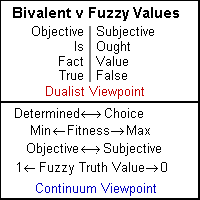
If we make the assumption that our various associations are combined in a form of fuzzy decision making [Dimitrov] then we may be able to better model complex social systems and to better understand the interplay of incompatible values and how these are generally solved by our intuition. This however is a distant dream, all we can say so far is that in most cases these intuitive judgements do not take into account much outside our own lives. We can however ask why this is so and here we need to investigate the influences on our behaviour and beliefs that cause us to concentrate on selfish and simplified analyses of the situations we face. We can guess that our value judgements are as much emotional as rational [Bickhard1999a] and thus intuitive decision making seems to depend upon the set of biases or inclinations originating from mind and body as an evolved whole [Rolls].
 When we investigate our intellectual functioning we find from neurological evidence that this has an emotional component [Damasio, Lucas1997] that is not disjoint from our rational mind but intimately tied up with our ability to make coherent decisions [Barnes & Thagard]. Neurologically we see that the cortex is directly linked to
the amalgyda as well as having the expected pathway via the thalamus. Experiments have shown that our emotional reactions are faster than our rational thought
[Goleman], so we can confirm that rapid decisions are made on more emotional than intellectual grounds. We thus need to examine where these emotional
biases come from, since it is only by changing these deep seated beliefs that we can alter
the general direction of our automatic behaviours and thus our inbuilt day-to-day fitness assumptions.
When we investigate our intellectual functioning we find from neurological evidence that this has an emotional component [Damasio, Lucas1997] that is not disjoint from our rational mind but intimately tied up with our ability to make coherent decisions [Barnes & Thagard]. Neurologically we see that the cortex is directly linked to
the amalgyda as well as having the expected pathway via the thalamus. Experiments have shown that our emotional reactions are faster than our rational thought
[Goleman], so we can confirm that rapid decisions are made on more emotional than intellectual grounds. We thus need to examine where these emotional
biases come from, since it is only by changing these deep seated beliefs that we can alter
the general direction of our automatic behaviours and thus our inbuilt day-to-day fitness assumptions.
Here we must take into account instinct or reflex actions, and the inherent evolutionary or animal biases on our behaviour as studied in Evolutionary Psychology [Wright], which regards emotions as superordinate programs that activate or de-activate sets of needs or values in a contextual way [Cosmides & Tooley]. These influences often skew our fitness judgements towards selfish or short sighted actions, since these are the actions most beneficial to a primitive lifestyle. In modern society however our global interdependence can make such behaviours self-defeating, and we need to look towards modes of action that take into account more than one value at a time and better balance out the wider implications of our choices [Thagard]. It is here that a rational scientific analysis can clarify our inherent biases and identify the wider options available and thus help us lay down better intuitive responses to life's perturbations [Lucas1999a]. It is our whole approach to life, our evolved assumptions, that sets the stage for our fitness evaluations and if we are to integrate values better into our science, and science better into our lives, then this aspect needs to be examined.
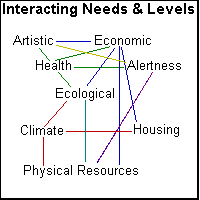 In order to evaluate scientifically systems based upon metaneeds (i.e. mind) we need to employ
concepts of theory fitness that can cover complex value interactions, that can relate to
these multi-level values. We need also to recognise that at each level multiple aspects will
exist simultaneously (the different needs listed earlier for example). We cannot isolate a
single value (e.g. scientific prediction or energy) and maximise its fitness alone, since changes to
properties affecting that dimension may have knock-on effects on the other dimensions that use
the same parts or are connected to them. For example, maximising our freedom
implies that we have no responsibility or obligation to others, but this conflicts
with various other values e.g. justice, compassion and companionship. On a more
material level, maximising engine power conflicts with minimising pollution
and cost. These interplays of values mean that we cannot understand single
aspects of any complex system in isolation, but must also understand how the variables
interact and compromise in providing the overall multiple functions that are
common to such systems. This is a shift in perspective from normal science and conscious thought,
which usually concentrates on isolated contexts and assumptions of disjoint or independent properties, leading to assumptions and intuitions of model behaviour which are often
incorrect [Doyle, Forrester].
In order to evaluate scientifically systems based upon metaneeds (i.e. mind) we need to employ
concepts of theory fitness that can cover complex value interactions, that can relate to
these multi-level values. We need also to recognise that at each level multiple aspects will
exist simultaneously (the different needs listed earlier for example). We cannot isolate a
single value (e.g. scientific prediction or energy) and maximise its fitness alone, since changes to
properties affecting that dimension may have knock-on effects on the other dimensions that use
the same parts or are connected to them. For example, maximising our freedom
implies that we have no responsibility or obligation to others, but this conflicts
with various other values e.g. justice, compassion and companionship. On a more
material level, maximising engine power conflicts with minimising pollution
and cost. These interplays of values mean that we cannot understand single
aspects of any complex system in isolation, but must also understand how the variables
interact and compromise in providing the overall multiple functions that are
common to such systems. This is a shift in perspective from normal science and conscious thought,
which usually concentrates on isolated contexts and assumptions of disjoint or independent properties, leading to assumptions and intuitions of model behaviour which are often
incorrect [Doyle, Forrester].
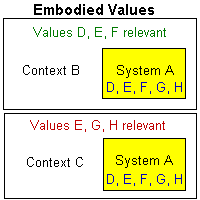 Overall fitness relates to a correlation between the system and its environment,
such that the operation of the combined whole achieves an optimum result for
the system (and conversely an optimum result for the environment also - an Evolutionary
Stable System [Weibull]). Thus a metascientific theory must additionally take into account how the
system function depends upon the context in which it is found. This is relatively easy
with manmade systems, since they were designed to meet certain needs and the
relevance of all the system features are known. For natural systems and
especially mind, this is much more difficult. System function has arisen in a coevolutionary
way over a long period and different functions and values are relevant in differing
contexts. This context relativity applies also to science itself and we may need to
use different forms of science in different contexts (e.g. Newtonian and Quantum physics).
The idea of a global scientific viewpoint
depends upon a context that is globally valid and this incorporates assumptions of
absolute space, time and theory applicability that are nowadays known to be problematical [Akhundov].
In teleologically driven systems such absolutes are never universally
valid, since our experiences are always different and the combination of these and our
environment creates unique situations with associated unique values and fitnesses.
Metascience thus needs to have the context in which it is used explicitly specified.
Overall fitness relates to a correlation between the system and its environment,
such that the operation of the combined whole achieves an optimum result for
the system (and conversely an optimum result for the environment also - an Evolutionary
Stable System [Weibull]). Thus a metascientific theory must additionally take into account how the
system function depends upon the context in which it is found. This is relatively easy
with manmade systems, since they were designed to meet certain needs and the
relevance of all the system features are known. For natural systems and
especially mind, this is much more difficult. System function has arisen in a coevolutionary
way over a long period and different functions and values are relevant in differing
contexts. This context relativity applies also to science itself and we may need to
use different forms of science in different contexts (e.g. Newtonian and Quantum physics).
The idea of a global scientific viewpoint
depends upon a context that is globally valid and this incorporates assumptions of
absolute space, time and theory applicability that are nowadays known to be problematical [Akhundov].
In teleologically driven systems such absolutes are never universally
valid, since our experiences are always different and the combination of these and our
environment creates unique situations with associated unique values and fitnesses.
Metascience thus needs to have the context in which it is used explicitly specified.
Before we look at multidimensional issues we need to be clear about the fitness effects of simple interactions. Here we will use the Game Theory ideas of zero, positive and negative-sum transactions. But we will also claim that, despite the frequent use of a zero-sum mode in the literature, that that type of transaction is inapplicable in the real world. A commodity exchange always has greater marginal fitness or utility to one of the parties, for example money is more useful to the poorer party than to the richer.
Four simple types of such transactions can be identified (Table 2):
Table 2: Forms of Transaction
| Transaction | Fitness Formula | Example |
| Mutually beneficial | F(a)+F(b) < F(a+b) | cleaner fish, lichen (symbiosis) |
| Beneficial for one, neutral for other | F(a)+F(b) < (1+x)F(a)+F(b) | shelter under a tree (commensalism) |
| Beneficial for one, destructive for other | F(a)+F(b) > (1+x)F(a)+(1-y)F(b) | predator/prey, exploitation (parasitism) |
| Mutually destructive | F(a)+F(b) > F(a+b) | war, fighting, conflict (competition) |
The first two forms enhance absolute fitness so this we regard as positive-sum, the last two decrease it and thus are defined as negative-sum (both terms are defined here with respect to the isolated fitnesses of the agents). To maximise fitness we need to choose the transaction types with the greatest benefit and this means identifying the options in state space with the greatest positive-sum effects.
Having mentioned the fitness benefits of positive-sum transactions, we need to explain why competition is regarded here as negative-sum, especially as such behaviours are so evident in our society. What does competition achieve [Kohn] ? In biology survival relates to differential or local fitness, not to absolute or global fitness, thus competition can improve relative survival - presuming that an either/or choice must be made between you and me, and that is a critical point. In most human scenarios several other options are available, there are opportunities for 'value add', for increasing the fitness of both parties with respect to a full worldview. These relate to untried options in state space, and allow for growth and innovation. Failure to consider these wider aspects of fitness can lead to many unforeseen and hidden losses (Table 3):
Table 3: Competitive Losses
| Loss Type | Coevolutionary Fitness Result |
| Anxiety | demotivation due to stress and failures |
| Poor Self-Esteem | depression due to unfavourable comparisons |
| Disunity | breakdown of social structures and trust |
| Retaliation | coevolution means my nastiness will be returned, hurting me |
| Destructiveness | mutual negation of advantage (Red Queen effect) |
| Waste | many resources are needed to pursue the competitive scenario, e.g. advertising |
| Lost Opportunities | enemies never try to cooperate, even when obviously beneficial |
| Deceit Costs | lack of trust means effort is wasted in monitoring and verification |
| Monopoly Costs | preventing new market entrants itself imposes costs |
The tendency, in a male dominated society, to divide and treat all issues as either/or - a justice oriented ethic, rather than the more feminine approach of considering both sides - a care oriented ethic, has been previously remarked e.g. [Gilligan]. Complexity in its very structure is the end result of parts working together, and so if we are to have a suitable science of complexity then it seems evident that we must replace the divisive object oriented approach often seen in science by a connectionist or process oriented viewpoint, that explicitly recognises mutuality and interdependence.
The idea that organisms need not compete destructively but can achieve a mutually beneficial balance brings us to synergy. This says that parts combined have different effects than the parts alone (the whole is not equal to the sum of the parts) and extends fitness measurement to the whole system. We already know that one part can have a negative effect on another (e.g. the predator on prey) but it is often forgotten in our competitive society that this is a minor aspect of nature, cooperative effects are far more common and fitter in absolute terms [Kropotkin, Margulis]. These include the emergence effects common to complexity thinking (molecules making cells, cells making organisms, organisms making societies) but also much more. A group of people can achieve what a single one cannot (e.g. building a Cathedral), division of labour increases efficiency and thus group fitness. Symbiosis between fungi and plants is essential for survival in 90% of species, eukaryotic cells are forms of symbiosis, humans also cannot survive without bacterial symbionts [Corning]. At all levels of nature advantages arise from associations between organisms and this should be true in any type of complex system.
Synergy comes in many forms, [Corning] for example lists the following (Table 4):
Table 4: Synergy Types
| Form of Synergy | Example of Fitness Enhancement |
| Linear Effects | size advantages due to grouping together, e.g. army power |
| Threshold Phenomena | overcoming a barrier, e.g. lifting a large rock |
| Phase Transitions | oxygenation of the primordial atmosphere |
| Emergent Phenomena | alloys with different properties to the constituents |
| Functional Complementaries | complementary parts, e.g. Velcro |
| Augmentation & Facilitation | catalysts |
| Environmental Conditioning | huddling together to save warmth |
| Risk & Cost Sharing | flocking, collective foraging |
| Information Sharing | gaining knowledge without trial and error |
| Society | division of labour, mutual help |
| Functional Convergencies | fortuitous by-products of selfish actions, e.g. market prices |
In all these cases fitness advantages arise from working together, whether explicitly or implicitly. The combined system exhibits a step jump in properties. New options arise for this reason alone, and this means that state space expands, it increases dimensionality. New emergent values are created which allow the exploration of new possibilities and the further innovative growth in complexity that leads to multilevel complex systems.
 Complex systems with multiple feedback loops can generate trajectories that both cumulatively increase and reduce fitness, as well as combinations of these tendencies, yet the current emphasis on conflict within fitness studies obscures the fact that
systems operate extensively in a modular way, indeed in artificial system design modularity
is well recognised as an essential feature giving flexibility and efficiency. Studies on the
fitness effects of such synergies are rare (this mutually beneficial cooperation is not
the same as the sacrifice altruism sometimes considered in population genetics) and may
perhaps best be seen in scenarios
like the 'Iterated Prisoners Dilemma' where ongoing cooperation can be shown to be
fitter than selfish behaviours [Axelrod]. But even here studies are limited to a single level, it is hard to relate this one-dimensional fitness to the synergistic
benefits of multi-organism interactions, where emergent values or functions add extra levels to
the fitness calculation [Judge]. All these
levels however are equally important to a complexity view and an overall fitness evaluation
must consider the infrastructure enhancement plus the debasement resulting from our
social actions. Some progress in recognising the importance of modularity as
a way of improving absolute fitness and generating complexity is now evident [Maynard Smith & Szathmary], but
much more needs to be done before such an approach is put on a solid and systemic footing.
Complex systems with multiple feedback loops can generate trajectories that both cumulatively increase and reduce fitness, as well as combinations of these tendencies, yet the current emphasis on conflict within fitness studies obscures the fact that
systems operate extensively in a modular way, indeed in artificial system design modularity
is well recognised as an essential feature giving flexibility and efficiency. Studies on the
fitness effects of such synergies are rare (this mutually beneficial cooperation is not
the same as the sacrifice altruism sometimes considered in population genetics) and may
perhaps best be seen in scenarios
like the 'Iterated Prisoners Dilemma' where ongoing cooperation can be shown to be
fitter than selfish behaviours [Axelrod]. But even here studies are limited to a single level, it is hard to relate this one-dimensional fitness to the synergistic
benefits of multi-organism interactions, where emergent values or functions add extra levels to
the fitness calculation [Judge]. All these
levels however are equally important to a complexity view and an overall fitness evaluation
must consider the infrastructure enhancement plus the debasement resulting from our
social actions. Some progress in recognising the importance of modularity as
a way of improving absolute fitness and generating complexity is now evident [Maynard Smith & Szathmary], but
much more needs to be done before such an approach is put on a solid and systemic footing.
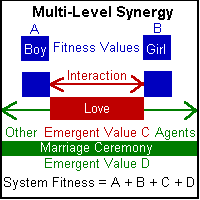 The idea that we can obtain a higher fitness by creating a new level of complexity takes
us beyond most current complexity or social studies and into the area of innovative effects,
and suggests that we should pay serious attention to the synergistic fitness benefits of
metaneeds and higher levels generally [Benson]. Studying such emergence makes explicit this quantum
jump in system operation and takes into account how a new viewpoint appropriate to this new situation affects how we regard the system parts and their contextual fitness. In social choice terms, such a viewpoint requires that we recognise that society is a different level to self and that the fitness of society contextually determines to some extent the fitness of our personal options.
This means that we cannot make correct fitness decisions without taking into account both other people's reactions (social modules)
and collective effects (social levels). A metascience viewpoint can help treat these cases
by making explicit just which levels and needs need to be considered in any case, and in helping
us to recognise the justification for what we include and exclude from our decision process.
The idea that we can obtain a higher fitness by creating a new level of complexity takes
us beyond most current complexity or social studies and into the area of innovative effects,
and suggests that we should pay serious attention to the synergistic fitness benefits of
metaneeds and higher levels generally [Benson]. Studying such emergence makes explicit this quantum
jump in system operation and takes into account how a new viewpoint appropriate to this new situation affects how we regard the system parts and their contextual fitness. In social choice terms, such a viewpoint requires that we recognise that society is a different level to self and that the fitness of society contextually determines to some extent the fitness of our personal options.
This means that we cannot make correct fitness decisions without taking into account both other people's reactions (social modules)
and collective effects (social levels). A metascience viewpoint can help treat these cases
by making explicit just which levels and needs need to be considered in any case, and in helping
us to recognise the justification for what we include and exclude from our decision process.
Applying any new theory to a wide range of applications is a difficult task in itself, and
when we attempt to change hundreds of years of scientific and spiritual prejudices
we can see that such a move cannot happen overnight. Yet in many ways the time is
ripe for such a transformation of viewpoint. In all areas of modern human endeavour the
need for an integrated perspective on mind is being recognised, whether this is scientific
[e.g. Capra], spiritual [e.g. Wilber] or social [e.g. Senge].
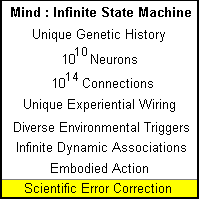 This need to dissolve the many
dualisms we have inherited from the part encourages the development of a new
scientific methodology, such as the one suggested here. There are very many possibilities in
complex systems such as the mind and we need a viewpoint that does not artificially suppress or close off these
options. This requires that we take into account not only our traditional scientific
values, but also those of the wider society around us, and these include many
non-material values.
This need to dissolve the many
dualisms we have inherited from the part encourages the development of a new
scientific methodology, such as the one suggested here. There are very many possibilities in
complex systems such as the mind and we need a viewpoint that does not artificially suppress or close off these
options. This requires that we take into account not only our traditional scientific
values, but also those of the wider society around us, and these include many
non-material values.
The use of a process mode of thought, rather than a object oriented methodology, can ease this integration and make more natural the idea that evolutionary rather than static views are necessary in order to cope with the ever increasing rate of change in our world. Decisions are always evolutionary, they relate to trajectories in state space, novelty in our lives as we explore new combinations of ideas. Our current position on the fitness landscape is dependent upon our entire iterative history and cannot be understood in isolation from that. But it is not determined by either biological or cultural constraints, our abstract abilities allow us to model our development options, to consider metafitness with an objective detachment. This ability to ask of any idea "what difference does it make ?" can be used to bring a more useful scientific perspective to bear on ethical, aesthetic and spiritual values as well as materialistic and biological ones.
 We have had three agendas within this paper, firstly to dissolve the dualistic thinking behind
science so that we can admit both subjective viewpoints and values into modern scientific
practice - this required the recognition of the importance of associations and fitness concepts.
Secondly to outline an explicit metascientific methodology that extends science in four ways: it considers all of state space rather than just local optima, it recognises that the aims of science are teleological in nature, it includes needs or values at multiple levels, and it takes into account their contextual interactions
in providing assessments of the fitness or benefit of the various possible choices. Thirdly we
have examined human decisions and looked at how these are made and what the actual
influences on our decision making may be. We here recognise the difference between the
explicit and mathematical decision making of a small number of rational scientific experts and the intuitive,
emotional and fuzzy decisions common to the lives of most unscientific people. The need to
change the perception of the masses by incorporating a more applicable form of science
into their daily lives and choices has been emphasised.
We have had three agendas within this paper, firstly to dissolve the dualistic thinking behind
science so that we can admit both subjective viewpoints and values into modern scientific
practice - this required the recognition of the importance of associations and fitness concepts.
Secondly to outline an explicit metascientific methodology that extends science in four ways: it considers all of state space rather than just local optima, it recognises that the aims of science are teleological in nature, it includes needs or values at multiple levels, and it takes into account their contextual interactions
in providing assessments of the fitness or benefit of the various possible choices. Thirdly we
have examined human decisions and looked at how these are made and what the actual
influences on our decision making may be. We here recognise the difference between the
explicit and mathematical decision making of a small number of rational scientific experts and the intuitive,
emotional and fuzzy decisions common to the lives of most unscientific people. The need to
change the perception of the masses by incorporating a more applicable form of science
into their daily lives and choices has been emphasised.
Science is a powerful influence on our world, but the dogma that it is without values is seen to be no more than a deceit. Ignoring the hidden values can lead to negative-sum actions, when the social disadvantages arising from the values ignored outweigh the materialistic advantages gained. Without an explicit empirical methodology this cannot be quantified, with such a methodology, as outlined here, we can examine both scientifically based and socially based claims and identify limitations and more positive-sum options. Maximising simple values out of context ignores the importance of synergy and the function of the whole in generating new values, new levels of complexity and possible fitness. The neglect of this area so far within complexity studies is regrettable, not only in general terms but also in understanding the nonlinear interaction of values in our minds and in our social discourse that forms such an influence on our practical fitness choices, and which, if considered, can generate far more elegant solutions to our problems.
Zadeh, Lotfi. (1987), Fuzzy Sets and Applications: Selected Papers. eds. Yager, Ovchnikov, Tong & Nguyen. Wiley.